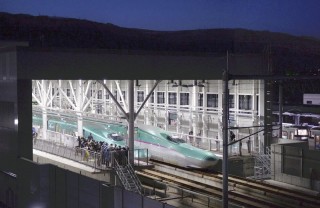Loading
Search
▼ High Hopes for Hokkaido Shinkansen
- Category:Other
By Hiroyuki Yoneyama and Masanori Matsumoto / Yomiuri Shimbun Staff Writers
With the opening of the Hokkaido Shinkansen line on March 26, the islands of Hokkaido, Honshu and Kyushu have finally been linked by bullet train — 43 years after plans for a national high-speed rail network were first laid out in 1973. Although regions across the country have high hopes that construction of Shinkansen lines will be an economic boon, the plans are facing problems, including profitability and securing funds.
Hotels booming
After the first Hokkaido Shinkansen train, Hayabusa No. 10, departed Shin-Hakodate-Hokuto Station at 6:35 a.m. on the inaugural day, Hokkaido Gov. Harumi Takahashi said: “The opening of the Shinkansen marks the start of a new challenge. I hope we can vitalize Hokkaido by attracting as many passengers as possible.”
Hotels in Hakodate were nearly full on March 26 and 27. In what is normally a quiet period before the long Golden Week holiday period that starts in late April, reservations were 30 percent above average for the month. At the Hakodate Morning Market near Hakodate Station, a seafood shop selling delicacies such as crab and shishamo smelt enjoyed an about 1.5-fold sales increase compared to the previous weekend.
Construction of a large-scale shopping facility in front of Hakodate Station is wrapping up before its planned summer opening. Car rental companies have opened branches in front of Shin-Hakodate-Hokuto Station, and next February a new commercial complex whose tenants include a hotel and restaurants will open.
Reservations only at 24%
The Hokkaido Shinkansen line appears to have made a good start, but the 24 percent reservation rate for the route between Shin-Hakodate-Hokuto and Shin-Aomori for the first nine days reveals a dimmer outlook.
The combined basic fare and express ticket between Tokyo and Shin-Hakodate-Hokuto is less expensive than the fares of major airlines between Haneda and Hakodate airports, but the difference, when discounted tickets are taken into account, is minor.
The fastest train between Tokyo and Shin-Hakodate-Hokuto takes four hours and two minutes — just missing the four-hour barrier at which high-speed trains are considered competitive against airplanes.
Although All Nippon Airways (ANA) discounted its fares in response to the opening of the Hokuriku Shinkansen line extension to Kanazawa, company President Osamu Shinobe was calm about the Hokkaido Shinkansen line, declaring that ANA is “not taking any special measures” in response.
According to Hokkaido Railway Co. (JR Hokkaido), even if the new line attracts a 30 percent share of the travel market for passengers to Tokyo, the increased expense of maintaining the Seikan Tunnel that connects Hokkaido and Honshu is expected to result in an average loss of ¥4.8 billion each year from fiscal 2016 to 2018.
Losses have become standard for JR Hokkaido — as demonstrated in its consolidated financial report for fiscal 2015 ending in March, in which a ¥42 billion operating shortfall is expected — and the firm has been maintaining itself with support from the central government. It is essential for the company to lead the opening to an improvement in performance.
Speed, safety measures
Thorough safety measures are required for the Hokkaido Shinkansen line, which not only runs through a cold area but also shares an 82-kilometer stretch of track — of which 54 kilometers are in the Seikan Tunnel — with freight trains. For the time being, high-speed trains will be limited to 140 kph along the shared segments to prevent wind pressure from impacting passing freight trains.
It is also easy for snow and ice to accumulate at the point where the tracks branch off. That portion has been covered like a tunnel and outfitted with electric heaters to melt the snow and also compressed air equipment to blow it away. A JR Hokkaido official said they “must engage in safety maintenance by increasing staff numbers in limited periods.”
Inside the tunnel, unused undersea train stations are equipped with cable cars for evacuation to the surface. The capacity of these will be increased from the current 15 to 38 in August.
3 lines await completion
With the opening of the Hokkaido Shinkansen line on March 26, the islands of Hokkaido, Honshu and Kyushu have finally been linked by bullet train — 43 years after plans for a national high-speed rail network were first laid out in 1973. Although regions across the country have high hopes that construction of Shinkansen lines will be an economic boon, the plans are facing problems, including profitability and securing funds.
Hotels booming
After the first Hokkaido Shinkansen train, Hayabusa No. 10, departed Shin-Hakodate-Hokuto Station at 6:35 a.m. on the inaugural day, Hokkaido Gov. Harumi Takahashi said: “The opening of the Shinkansen marks the start of a new challenge. I hope we can vitalize Hokkaido by attracting as many passengers as possible.”
Hotels in Hakodate were nearly full on March 26 and 27. In what is normally a quiet period before the long Golden Week holiday period that starts in late April, reservations were 30 percent above average for the month. At the Hakodate Morning Market near Hakodate Station, a seafood shop selling delicacies such as crab and shishamo smelt enjoyed an about 1.5-fold sales increase compared to the previous weekend.
Construction of a large-scale shopping facility in front of Hakodate Station is wrapping up before its planned summer opening. Car rental companies have opened branches in front of Shin-Hakodate-Hokuto Station, and next February a new commercial complex whose tenants include a hotel and restaurants will open.
Reservations only at 24%
The Hokkaido Shinkansen line appears to have made a good start, but the 24 percent reservation rate for the route between Shin-Hakodate-Hokuto and Shin-Aomori for the first nine days reveals a dimmer outlook.
The combined basic fare and express ticket between Tokyo and Shin-Hakodate-Hokuto is less expensive than the fares of major airlines between Haneda and Hakodate airports, but the difference, when discounted tickets are taken into account, is minor.
The fastest train between Tokyo and Shin-Hakodate-Hokuto takes four hours and two minutes — just missing the four-hour barrier at which high-speed trains are considered competitive against airplanes.
Although All Nippon Airways (ANA) discounted its fares in response to the opening of the Hokuriku Shinkansen line extension to Kanazawa, company President Osamu Shinobe was calm about the Hokkaido Shinkansen line, declaring that ANA is “not taking any special measures” in response.
According to Hokkaido Railway Co. (JR Hokkaido), even if the new line attracts a 30 percent share of the travel market for passengers to Tokyo, the increased expense of maintaining the Seikan Tunnel that connects Hokkaido and Honshu is expected to result in an average loss of ¥4.8 billion each year from fiscal 2016 to 2018.
Losses have become standard for JR Hokkaido — as demonstrated in its consolidated financial report for fiscal 2015 ending in March, in which a ¥42 billion operating shortfall is expected — and the firm has been maintaining itself with support from the central government. It is essential for the company to lead the opening to an improvement in performance.
Speed, safety measures
Thorough safety measures are required for the Hokkaido Shinkansen line, which not only runs through a cold area but also shares an 82-kilometer stretch of track — of which 54 kilometers are in the Seikan Tunnel — with freight trains. For the time being, high-speed trains will be limited to 140 kph along the shared segments to prevent wind pressure from impacting passing freight trains.
It is also easy for snow and ice to accumulate at the point where the tracks branch off. That portion has been covered like a tunnel and outfitted with electric heaters to melt the snow and also compressed air equipment to blow it away. A JR Hokkaido official said they “must engage in safety maintenance by increasing staff numbers in limited periods.”
Inside the tunnel, unused undersea train stations are equipped with cable cars for evacuation to the surface. The capacity of these will be increased from the current 15 to 38 in August.
3 lines await completion
The three segments of the national high-speed rail network that have yet to be completed are the extension of the Hokkaido Shinkansen line to Sapporo, the section of the Hokuriku Shinkansen line connecting Kanazawa to Osaka, and the Nagasaki route of the Kyushu Shinkansen line.
The extension to Sapporo is planned for completion at the end of fiscal 2030. If Sapporo succeeds in attracting the 2026 Winter Olympics, the project will be given an energy boost.
Iwao Takamuki, chairman of the Federation of Hokkaido Chamber of Commerce and Industry, emphasized that “it is also essential to boost the business impact outside of just tourism.”
There are plans to expand the Hokuriku Shinkansen line to Tsuruga in Fukui Prefecture in fiscal 2022, but a decision on a possible extension of that line from Tsuruga to Osaka has still not been made.
The Nagasaki route of the Kyushu Shinkansen line has been plagued by delays in the development of “free-gauge train” technology, which allows for the adjustment of the distance between wheels to run on wide or narrow tracks. Consequently, direct trains between Hakata and Nagasaki will initially be limited when that line opens in fiscal 2022.
Amid a tough financial environment, the central government has set out about ¥75 billion per year for the construction of Shinkansen lines.
Arguing that bringing forward the opening dates for these lines is essential for tapping into demand from foreign visitors, some within the ruling bloc — including Tomomi Inada, who chairs the Liberal Democratic Party Policy Research Council — are calling for a budget increase.
However, budget resources of about ¥540 billion were needed when the government decided in 2015 to bring forward the completion of these three segments by three to five years. Securing additional funds may prove challenging.
The extension to Sapporo is planned for completion at the end of fiscal 2030. If Sapporo succeeds in attracting the 2026 Winter Olympics, the project will be given an energy boost.
Iwao Takamuki, chairman of the Federation of Hokkaido Chamber of Commerce and Industry, emphasized that “it is also essential to boost the business impact outside of just tourism.”
There are plans to expand the Hokuriku Shinkansen line to Tsuruga in Fukui Prefecture in fiscal 2022, but a decision on a possible extension of that line from Tsuruga to Osaka has still not been made.
The Nagasaki route of the Kyushu Shinkansen line has been plagued by delays in the development of “free-gauge train” technology, which allows for the adjustment of the distance between wheels to run on wide or narrow tracks. Consequently, direct trains between Hakata and Nagasaki will initially be limited when that line opens in fiscal 2022.
Amid a tough financial environment, the central government has set out about ¥75 billion per year for the construction of Shinkansen lines.
Arguing that bringing forward the opening dates for these lines is essential for tapping into demand from foreign visitors, some within the ruling bloc — including Tomomi Inada, who chairs the Liberal Democratic Party Policy Research Council — are calling for a budget increase.
However, budget resources of about ¥540 billion were needed when the government decided in 2015 to bring forward the completion of these three segments by three to five years. Securing additional funds may prove challenging.
- April 5, 2016
- Comment (0)
- Trackback(0)



